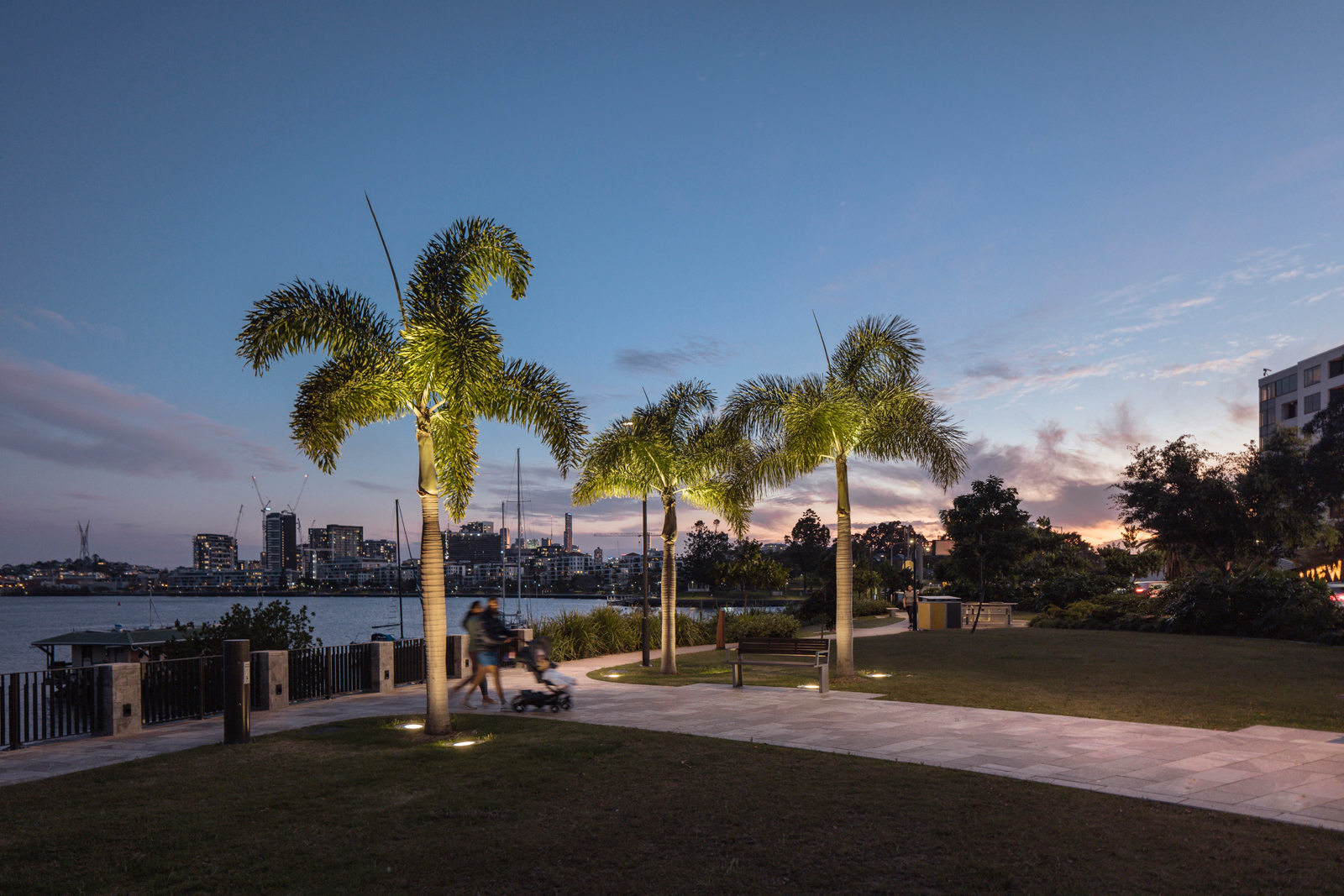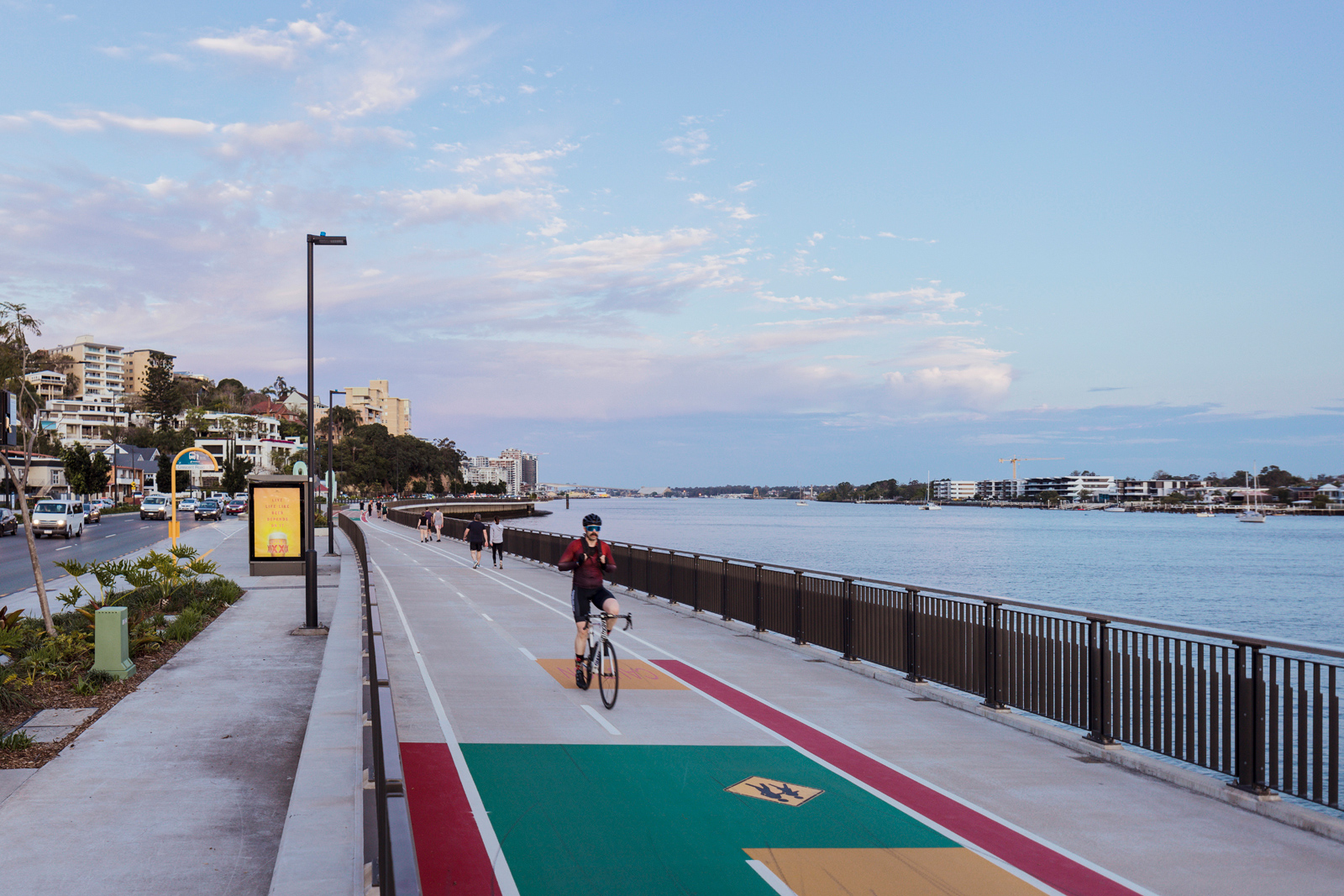
PEDESTRIAN, UPLIGHTING
Upgrading a busy Brisbane road and pathway for pedestrians and cyclists
- Completed2018
- ClientBrisbane City Council
- Sales PartnerRaylinc Lighting
- Lighting DesignDesign Stage Pty Ltd
- BuilderLendlease
- PhotographyJackie Chan
A busy area connecting the Brisbane CBD to the airport required upgrading to the lighting installation which incorporated a lot of landscape lighting to the median strip and pathways alongside the road.
Challenges
This project was a very big one with many challenges. One in particular being that given the structure needed to be built over the water, the project used prefabricated slabs and the detailing for all of the lighting plans, including conduit and cables and blockouts for ingrounds, needed to be done before the prefabrication process. “There is very little room for error here, because once the conduit is sandwiched between the prefabricated slabs, it needs to be able to go together almost like a jigsaw puzzle”, but at a much grander scale and it is very difficult to change later on – explained Senior Lighting Designer, James Sparks of Design Stage.
There were many different builders involved along the 9 km stretch, which also presented challenges for the lighting designers to ensure consistency of the lighting throughout the entire project. There were for example requests for a combination of different lighting controls to be used throughout the program, which the lighting designers needed to work hard to persuade the stakeholders against mixing controls, to ensure continuity across the project.
Key Considerations
– Warm whites for pathways: The lighting design aimed to illuminate pathways for pedestrians and cyclists while adding feature lighting to the gardens. The lighting designers prioritised capturing a warm white ambience
– Minimising spill light: It was essential to prevent street lighting from spilling onto the pathways and ensure that pathway lighting exclusively illuminated pedestrian areas and highlighted garden features
– Budgetary constraints: As a large project for the Brisbane City Council, staying within budget was crucial. The prefabrication aspect of the project had exceeded the budget, imposing pressures on various stages of construction, including the lighting
– Ensuring stakeholder buy-in: Gaining approval from all key stakeholders for the proposed lighting solutions was essential
– Warranty and product quality: The lighting designers valued warranty, product quality, and reliable service support to uphold their reputation for delivering high-quality luminaires.
“We are not willing to risk compromising the quality of the fittings that would be installed as this would then be a mark on our own reputation for quality”
Solution
While some stakeholders wanted to choose cheaper alternative lighting products than that of the WE-EF luminaires selected, the Lighting Designers on the project had specified WE-EF luminaires many times on previous projects and strongly believed in the warranty, product quality and service support that WE-EF has always provided.
In particular, the WE-EF Partner in Raylinc Lighting in Brisbane stood out as being very customer-service oriented, according to Senior Lighting Designer, James Sparks of Design Stage, who even went as far to say that “having worked with Mark, Peter and the team at Raylinc for many years, we always know that if there is ever a problem, even if it is a contractor installation issue, they will sort it out”.
When it comes to specifications and product quality, James Sparks also mentioned that “we are not willing to risk compromising the quality of the fittings that would be installed as this would then be a mark on our own reputation for quality”.
To address concerns about potential glare from the median strip ingrounds affecting drivers, Design Stage Lighting Designers collaborated with WE-EF LIGHTING’s technical team. Together, they conducted a comprehensive study and lighting design analysis, which concluded that the selected luminaires would not impact drivers significantly; and that in fact there is a far greater glare impact from onward vehicles’ headlights than any inground luminaires in the median strip. This study led to the approval of the specification, resulting in the installation of ETC300 circular inground luminaires and ETV100 linear inground luminaires as feature lighting for the median strip.
In total, the lighting installation included 220 x ETC300 ingrounds, 14 x ETV100 ingrounds, 65 x VFL530 street and area luminaires, and 12 x DAC220 catenary luminaires for landscaping and pathway lighting.
Results
The installed luminaires effectively addressed the project’s goals. The VFL530 street and area luminaires with the pedestrian/bicycle lane [P65] optic ensured controlled light distribution and output throughout the project. The pathways for pedestrians and cyclists featured a combination of ETC300 and ETV100 inground luminaires, along with VFL530 street and area luminaires, all emitting a warm white light to create a pleasant ambience while also lessening the impact on the local ecosystem.
In conclusion, the upgraded Kingsford Smith Drive and pathway now provide enhanced safety and aesthetics for pedestrians and cyclists. The project’s success can be attributed to the careful consideration of key factors, the selection of high-quality luminaires, and effective collaboration between the stakeholders involved.








